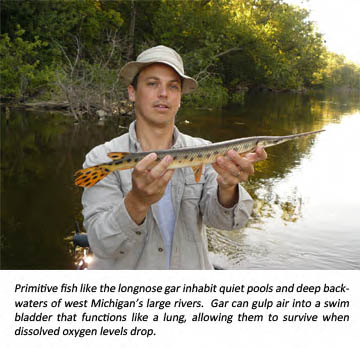Beyond bass: The Grand River is home to an incredible number of fish species
Large rivers provide diverse habitat that supports a multitude of fish. The Grand River Greenway maintains natural floodplains and benefits fish species that will be discussed on May 17 at the Grand Haven’s Loutit Library.
The setting is a dense forest of trees sprouting the new green leaves of spring. There is no carpet of leaf litter beneath the feet or bouquets of wildflowers to delight the senses. Instead, there is only water beneath the canopy of green. This is no time for a stroll in the woods, but it is the perfect time for a paddle through the flooded forest.
Tree trunks show the high water mark from past floods that reached another three feet above what is usually dry land. This is not the Amazonian rainforest or a delta river off the Mississippi — it is the Grand River in west Michigan. What seems familiar and tame in the dry heat of summer is remote and wild after the freshets of spring.
The water is not what one might envision for a Michigan wilderness experience. It is not clear, but rather mocha brown. Reach your hand in and it disappears inches beneath the surface. It is a foreign world to us — dark and churning with the detritus of all that washes into the river. This is not a thin ribbon of cold, blue water that teems with trout. It is a floodplain/river ecosystem that supports a far greater diversity of fish species than a cold water trout stream ever could.
The floodwaters may seem threatening to us, but they are
essential to the natural functioning of the river and a key to the diversity of
species found here. Old river channels create wetlands, oxbow lakes, sloughs
and bayous that connect to the main river during high water. They produce
different types of food for young fish than what is found in the river and are,
thus, prime  spawning and nursery habitat for many species.
spawning and nursery habitat for many species.
The big river itself provides spawning habitat for different species that require flowing water or undercut banks where cavities beneath tree roots make the perfect spot for a nest. The connections between the backwaters and river allow fish to move between the two over the course of their life and from season to season. Lake Michigan, too, provides cool and cold water habitat that is essential for certain species that only enter rivers during cooler months.
Familiar gamefish like steelhead and salmon display this behavior, but river connections are important to other species, too. Largemouth bass and bluegill use the backwaters to spawn in spring, but can also duck into the main river during the heat of summer. Bass, catfish, and walleye will move out of the river and into Lake Michigan as the river warms and water levels drop, while yellow perch move into rivermouth areas from Lake Michigan in late fall and spring.
To most anglers, these are all familiar species held in high esteem, but big river systems also provide homes for other unique native fish that are not as well-known or widely appreciated. Some are threatened species like the lake sturgeon and river redhorse. Others, like the quillback and flathead catfish, are locally abundant but found only in large river environments.
All told, at least 107 species of fish have been found in the Grand River system and all but a handful of these within forty miles of Lake Michigan. Maintaining high-quality floodplain habitat is important to maintaining this diversity and populations of important gamefish.
The Grand River Greenway Celebration is highlighting efforts of Ottawa County Parks to purchase land along the river for recreation and maintain natural areas that support fish and wildlife. At 7:00 PM on May 17 at Grand Haven’s Loutit Library, Michigan Sea Grant will be sharing pictures, videos, stories, and fun facts about some of the Grand’s fascinating fish species and the habitats that allow them to thrive.



 Print
Print Email
Email


